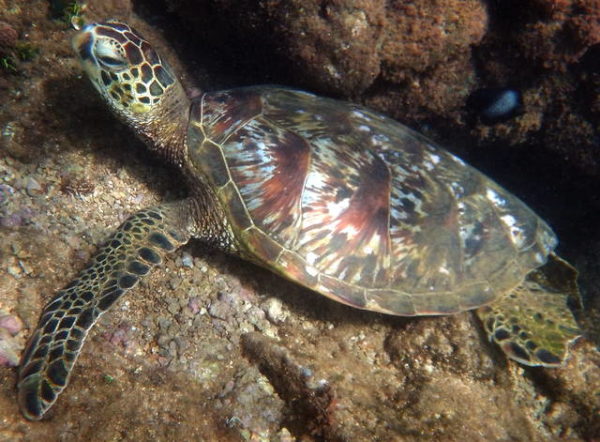Published in the Ocean Watch column, Honolulu Star-Advertiser © Susan Scott
July 29, 2017
While sitting in traffic last weekend off the North Shore’s Laniakea, one of our green turtles’ favorite hangouts, I saw a young woman sitting cross-legged inches from an enormous turtle. Greens, called honu in Hawaiian, grow to 4 feet long and weigh 400 pounds, and this one was close to the max.
Both creature and person had their eyes shut, the turtle sleeping, the woman meditating. As I watched this peaceful moment between wild animal and human being, I wondered for the zillionth time: What is it about sea turtles that touches so many of us so deeply?
 Turtles, with the green ones referred to locally as honu in Hawaiian, are a species of
Turtles, with the green ones referred to locally as honu in Hawaiian, are a species of
wild animals that are comfortable in the presence of humans. A young turtle barely
lifted her head as her photo was snapped and immediately drifted off to sleep.
©2017 Susan Scott
Our love affair begins in the dark, when turtle hatchlings burst from their sand nests like a box of wind-up toys. How we root for the little darlings as they scurry down the beach, the lucky ones dodging crabs, birds and fish that view baby turtles as food. Only 1 in 1,000 hatchlings makes it to adulthood.
As they grow, sea turtle shells turn into 13 little murals called scutes, radiating orange, yellow, brown, black and white. (The green of the name is the color of their body fat.) Sea turtle shells are so lovely that before international trade in so-called tortoiseshell was banned in the 1970s, people made jewelry, combs and endless other decorative items from turtle shells.
Palau women once shaped hawksbill turtle shells into shallow bowls called toluk and used them as money.
Besides admiring their designer jackets, we also love to watch turtles fly. Those long, strong flippers push those bulky bodies through the water with the grace of a deer.
Other wild animals possess poise and beauty, of course, but Hawaii’s honu have another quality that endears them to us like few other creatures: They don’t fear us.
Since gaining protection 44 years ago, green turtles have learned to accept people as part of the scenery. We swim next to them on the reef, glide past them on our surfboards and stand talking, pointing and clicking while they nap.
Even when human admirers swarm, as they tend to do at Laniakea, the turtles remain unruffled. As a researcher once told me when I worried about the crowds, “If the turtles didn’t like it, they wouldn’t come back.”
No law specifies the minimum distance people can approach a sea turtle, but both the National Oceanic and Atmospheric Administration and state Department of Land and Natural Resources recommend that swimmers and beachgoers stay at least 10 feet away.
You can help our honu by reporting harassment or injury to one of these two turtle rescue phone numbers: Weekday days: 725-5730. All other hours: 286-4377. For quick access, I have them in my contacts.
As I watched the meditating woman and slumbering turtle, I remembered a comment a Laniakea visitor wrote in a turtle guest book. Of course, we humans love sea turtles. They are “angels of the sea.”